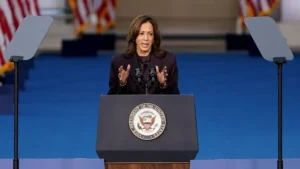The recent loss of Kamala Harris in her campaign has ignited discussions that extend beyond policy debates, focusing instead on the structural and external factors that may have influenced public opinion. Her defeat by a candidate with strong working-class backing points to both her own strategic miscalculations and the possible impact of entrenched institutional forces, often referred to as the “deep state.” This analysis reviews the obstacles Harris faced, the underlying institutional influences that may have shaped her campaign’s outcome, and insights for future political strategies.
STRATEGIC MISSTEPS & VOTER DISCONNECT
Harris’s campaign was centered on policies aimed at reducing income inequality, improving healthcare, and safeguarding workers’ rights—core issues for the working class. However, several strategic errors prevented her platform from resonating effectively:
1. Weak Working-Class Connection: While the Democratic Party has historically represented working-class interests, Harris faced significant challenges in restoring this trust, which has waned over time. Many working-class voters felt neglected, perceiving her promises as insufficient to bridge the divide formed by years of perceived inattention.
2. Complex Policy Messaging: Harris’s detailed proposals on wage increases, healthcare, and labor protections, though comprehensive, appeared overly intricate for some voters. This complexity hindered her ability to address urgent economic issues in relatable terms. Her opponent’s simpler, emotionally resonant messaging had greater appeal, particularly to those struggling with inflation and wage stagnation.
3. Cultural Disconnect: By focusing on progressive social policies, Harris’s campaign resonated more with urban voters, alienating those in suburban and rural areas. This created an impression that her agenda catered primarily to elite interests, weakening her standing among middle- and working-class families.
Together, these strategic issues left Harris’s campaign appearing disconnected from the day-to-day concerns of many Americans, ultimately affecting her credibility and support.
Institutional Influence and Media Dynamics
Beyond the internal campaign strategy, the role of institutional powers—often referred to as the “deep state,” here used to denote entrenched government and bureaucratic interests—may have subtly influenced both the campaign environment and voter perception. While complex, the influence of institutional forces may have impacted Harris’s campaign in the following ways:
1. Media Narrative Control: Connections between institutional powers and major media outlets likely shaped public perception by focusing on certain narratives while minimizing others. If Harris’s agenda clashed with these interests, institutional influence could have steered media coverage in ways that cast doubt on her policies, subtly affecting public opinion over time.
2. Policy Agenda Interference: Government interests often align with specific agendas, particularly in areas like national security and the economy. Harris’s labor-focused platform might have been seen as potentially destabilizing by these entities, prompting them to indirectly sway public sentiment against her proposals.
3. Cybersecurity and Intelligence Oversight: With rising cybersecurity concerns and the threat of foreign election interference, intelligence agencies play an increasingly pivotal role in election safeguarding.
If Harris’s policies were seen as misaligned with these agencies’ priorities, it could have influenced decisions on managing her campaign’s messaging, subtly impacting how cybersecurity issues were communicated.
4. Campaign Financing and Lobbying: Institutional power is also evident in the realm of campaign financing, where lobbying groups in defense, finance, and healthcare can influence a candidate’s viability.
If Harris’s policies appeared to counter these sectors’ interests, they may have directed financial backing elsewhere, further weakening campaign momentum.
Algorithmic Impact
Social media platform “X” (formerly Twitter), under Elon Musk’s leadership, played a pivotal role in amplifying certain narratives, often favoring populist content. Key strategies included:
• Algorithmic Amplification: “X” algorithms highlighted high-engagement posts, often those supporting Trump-aligned messaging, thus providing them more visibility.
• Selective Promotion: By emphasizing retweets and likes, the platform created an echo chamber favouring Trump’s online following, reinforcing his supporters’ engagement.
• Reduced Moderation: Musk’s approach to content moderation allowed politically charged content to spread more freely, intensifying one-sided narratives.
• Personal Influence: Musk’s own postings often aligned with narratives countering mainstream media, indirectly supporting content that was critical of Harris.
• Feedback Loops: Engagement-driven algorithms created self-reinforcing loops, continuously promoting polarizing narratives, which ultimately disadvantaged Harris.
Through these mechanisms, “X” fostered a digital environment favoring polarizing political figures, amplifying their reach and shaping public opinion.
Lessons for Harris and Democrats
To reconnect with working-class voters, Harris and the Democratic Party must reevaluate both their internal campaign strategies and the external institutional influences that can shape electoral dynamics. Key strategies moving forward include:
• Building Grassroots Coalitions: Engaging directly with voters to regain trust and build support from the ground up is essential.
• Simplifying Messaging: Clear, relatable messaging is crucial to reach economically distressed regions and address their immediate concerns.
• Understanding Institutional Influence: Recognizing how lobbying, media, and entrenched government interests shape campaigns will help future candidates navigate these forces effectively.
Kamala Harris’s campaign had highlighted the need for adaptability in the face of institutional power and media dynamics. For future candidates seeking to implement meaningful reforms and connect with working-class Americans, understanding and responding to these underlying influences will be vital to fostering sustained voter engagement and achieving electoral success.
Dr. Nishakant Ojha , Distinguished Foreign & Counter-Terrorism Expert














